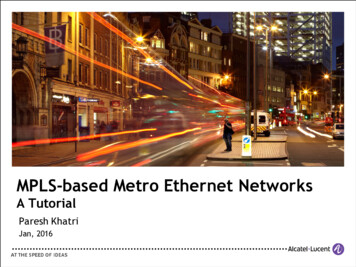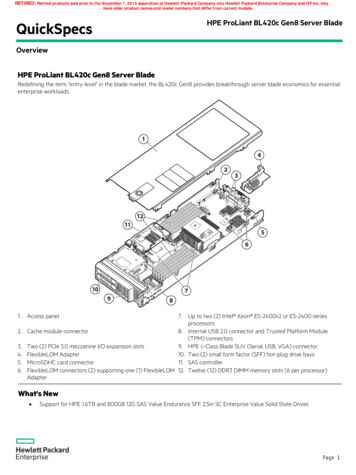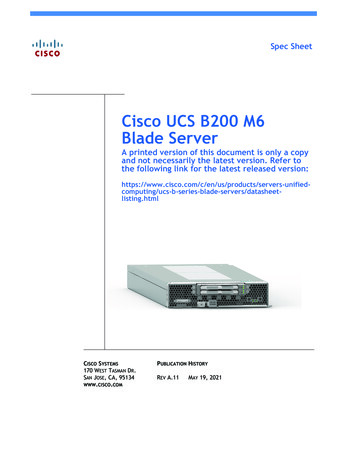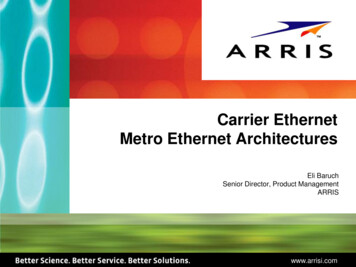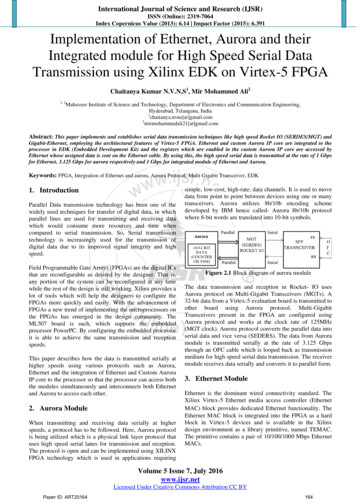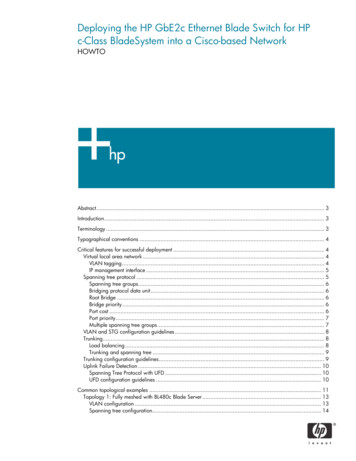
Transcription
Deploying the HP GbE2c Ethernet Blade Switch for HPc-Class BladeSystem into a Cisco-based NetworkHOWTOAbstract. 3Introduction. 3Terminology . 3Typographical conventions . 4Critical features for successful deployment . 4Virtual local area network . 4VLAN tagging. 4IP management interface . 5Spanning tree protocol . 5Spanning tree groups. 6Bridging protocol data unit . 6Root Bridge . 6Bridge priority. 6Port cost . 6Port priority. 7Multiple spanning tree groups. 7VLAN and STG configuration guidelines . 8Trunking. 8Load balancing . 8Trunking and spanning tree . 9Trunking configuration guidelines. 9Uplink Failure Detection . 10Spanning Tree Protocol with UFD . 10UFD configuration guidelines . 10Common topological examples . 11Topology 1: Fully meshed with BL480c Blade Server. 13VLAN configuration . 13Spanning tree configuration. 14
Port configuration . 15Trunking and EtherChannel. 15Topology 2: Partial mesh . 16VLAN configuration . 16Spanning tree configuration. 17Port configuration . 17Trunking and EtherChannel. 18Topology 3: Straight-through . 18VLAN configuration . 19Spanning tree configuration. 19Port configuration . 20Trunking and EtherChannel. 20Uplink Failure Detection configuration. 21Topology summary . 21Securing the GbE2c Ethernet Blade Switch . 22Management interfaces . 22Command line interface . 22Browser based interface. 22Setting source IP address range. 22SNMP management. 22RADIUS. 23TACACS . 23Passwords . 23Additional best practices . 23Appendix A: GbE2c Ethernet Blade Switch Architecture . 25Appendix B: GbE2c Ethernet Blade Switch default settings . 27For more information. 32
AbstractThis HOWTO provides best practice guidelines and configuration examples for installation of the HPGbE2c Ethernet Blade Switch into a Cisco-based network. This guide is meant to be a tool to helpdirect decisions in planning, optimizing and securing the GbE2c Ethernet Blade Switch environment.While the best practices and configurations examples in this document could be used in real worldenvironments, they are to be used only as guidelines. This HOWTO does not serve as a replacementfor the GbE2c Ethernet Blade Switch user guides, rather it is meant to serve as a supplement to thisdocumentation.The intended audience for this paper includes engineers and system administrators familiar with theGbE2c Ethernet Blade Switch for HP c-Class BladeSystem. For readers not familiar with GbE2cEthernet Blade Switch, please see the HP GbE2c Ethernet Blade Switch for c-Class BladeSystemoverview as well as the user documentation that shipped with the GbE2c Ethernet Blade Switch. Toobtain these documents, go to the HP website (http://www.hp.com/support), and search for GbE2c.IntroductionThis HOWTO identifies best practice guidelines and configuration examples for installation of the HPGbE2c Ethernet Blade Switch into a Cisco-based network consisting of redundant Catalyst 6509switches with the Catalyst switch operating system (CatOS). However, the examples in this documentcan be used as general guidelines appropriate for network infrastructures consisting of other Ciscoswitches, with the CatOS or Internetwork Operating System Software (IOS), and network devices fromother vendors including Nortel, Extreme, Foundry, 3Com, etc.The GbE2c Ethernet Blade Switch is intended for applications that require up to 1000 megabits persecond (Mb/s) Gigabit Ethernet network adapter (NIC) consolidation, advanced network featuresupport (including future planned options for layer 3). For additional information on the GbE2cEthernet Blade Switch, please see the HP GbE2c Ethernet Blade Switch for c-Class BladeSystemoverview on the HP website.TerminologyThe terminology that differs between the Cisco Catalyst 6509 switch and the GbE2c Ethernet BladeSwitch documentation is identified in Table 1.Table 1. Network terminology cross referenceHP GbE2c Ethernet Blade SwitchCisco Catalyst 6509 switchVLAN tagging, 802.1Q taggingtrunking, VLAN or 802.1Q encapsulationport VLAN identification (PVID)VLAN identification (VLANID)link aggregation, trunkingEtherChannel, channelingspanning tree protocol group (STG)spanning tree instanceIEEE 802.1d, Spanning Tree Protocolper VLAN Spanning Tree Plus (PVST )
Typographical conventionsThe following table describes the switch command typographic styles used in this guide:Table 2. Switch command typographical conventionsHP TypefaceMeaningExampleAaBbCc123This type displays in command examples andshows text that must be typed in exactly as shown./cfg/l2/vlan AaBbCc123 This italicized type displays in command examplesas a parameter placeholder. Replace theindicated text with the appropriate real name orvalue when using the command. Do not type thebrackets./cfg/l2/vlan vlan number To distinguish between HP GbE2c Ethernet Blade Switch and Catalyst 6509 commands, eachcommand will be preceded by a GbE2c and 6509#, respectively.Critical features for successful deploymentUnderstanding VLANs and VLAN tagging (VLAN trunking), spanning tree protocol, and trunking(channeling) is critical to the successful deployment of the GbE2c Ethernet Blade Switch. Each of thesetopics is covered providing a high-level primer inclusive of GbE2c Ethernet Blade Switch commandintroduction and general configuration guidelines. Specific commands and configuration steps followin the section titled “Common topological examples”. For additional information, refer to the HPGbE2c Ethernet Blade Switch Application Guide chapters 3 and 4.Virtual local area networkA virtual local area network (VLAN) is a network topology configured according to a logical schemerather than the physical layout. VLANs are used to logically segment traffic into different broadcastdomains allowing packets to be forwarded only between ports within the VLAN. This enhancesperformance by conserving bandwidth and improves security by limiting traffic to specific domains.The standard practice of configuring VLANs on an Ethernet switch is by assigning each port to aspecific VLAN. In this port-based VLAN implementation, the switch identifies the specific VLANmembership of a packet per the port on which it was received. Individual VLANs are defined via aconfigurable VLAN number. The VLAN number is known as port VLAN identification (PVID) on GbE2cEthernet Blade Switches and VLAN identification (VLANID) on Cisco Catalyst switches. The GbE2cEthernet Blade Switch allows any PVID value from 2 to 4095 with PVID 1 reserved as the defaultVLAN. The default GbE2c Ethernet Blade Switch configuration has all ports assigned to PVID 1.The IEEE industry standard for VLANs is 802.1Q. Each GbE2c Ethernet Blade Switch supports 255port-based IEEE 802.1Q VLANs. The GbE2c Ethernet Blade Switch VLAN menu can be found under:GbE2c /cfg/l2/vlan vlan number VLAN taggingVLAN tagging (often called VLAN trunking or encapsulation by Cisco) is the process of inserting intoa data frame a tag identifying its VLAN membership. VLAN tagging allows each switch port tobelong to multiple VLANs and provides the information switches need to communicate across thenetwork.Switch ports may be configured as tagged or untagged. A tagged port may receive tagged oruntagged frames and is capable of forwarding the frames appropriately. When a VLAN tagged
frame arrives at a tagged port, the switch looks at the PVID in the tag to determine its VLANmembership before switching the packet to the correct port. If an untagged frame arrives on a taggedport, the switch will tag the frame with the PVID of that port. If a frame exits the switch via a taggedport, any tag will remain on the frame unchanged as it exits.An untagged port is only capable of switching untagged frames. Therefore, an untagged port willonly see and accept incoming untagged frames. Frames received by the untagged port will beforwarded without any changes to the frame. For frames exiting the switch via an untagged port, anytag will be stripped from the frame before its forwarded.GbE2c Ethernet Blade Switch ports may be individually configured as tagged or untagged using thefollowing command:GbE2c /cfg/port port number /tag enaWhen implementing VLAN tagging on the GbE2c Ethernet Blade Switch, the PVID values must beestablished correctly between devices communicating in the VLAN. This option is found under:GbE2c /cfg/port port number /pvid PVID number IP management interfaceThe IP management interface provides management access to the GbE2c Ethernet Blade Switch overan IP network. By default, the IP management interface is configured to request its IP address from abootstrap protocol (BOOTP) server, but the IP address may also be assigned manually resulting inBOOTP being disabled.Carefully consider how VLANs are configured within the GbE2c Ethernet Blade Switch to ensureremote communication to the switch remains possible. In order to access the GbE2c Ethernet BladeSwitch for remote configuration, SNMP trap messages, and other remote management functions,confirm at least one IP management interface on the switch has a VLAN defined.It is possible to inadvertently disable access to management functions if the port associated with the IPmanagement interface is excluded from VLAN membership. Likewise, if all IP interfaces remain withinthe default VLAN (VLAN 1) and all ports are configured for a different VLAN, such as VLAN 2, thenGbE2c Ethernet Blade Switch management features are effectively disabled. To avoid these situations,it is suggested that all ports used for remote GbE2c Ethernet Blade Switch management remain on thedefault VLAN and that an IP management interface be assigned to the default VLAN.On the GbE2c Ethernet Blade Switch, assign the IP management interface to a VLAN using thecommands:GbE2c /cfg/l3/if number /mask mask /addr address GbE2c /cfg/l3/if number /vlan vlan# /ena/applySpanning tree protocolSpanning tree protocol (STP) is used to ensure that redundant paths within a layer 2 network do notresult in broadcast loops. For a layer 2 Ethernet network to function correctly, only one active pathmay forward frames between any two switches at a given time.Redundant connections between network switches can create loops or multiple forwarding paths. Inlayer 2 networks, these loops cause duplicate packets to be forwarded to the same destination overand over again until the network is completely saturated, which in turn prevents valid traffic fromtraversing the network. STP configures the network by allowing a switch to use the most efficient pathwhile forcing the remaining redundant paths into a standby (blocked) state. If the forwarding pathfails, STP automatically activates a standby path to sustain network operations.
Spanning tree groupsSTP examines the network topology and defines a tree structure spanning all switches in a given layer2 network domain. These layer 2 network domains are called spanning tree groups (STG). STGs arecreated by assigning a group of layer 2 switches to be part of a separate layer 2 network domain.When STP examines the network topology it only considers eliminating loops within a single STG.Within a layer 2 domain, there may be multiple STGs each operating its own individual STPalgorithm to eliminate layer 2 loops.The IEEE industry standard for STP is defined in 802.1D. The GbE2c Ethernet Blade Switch meets theIEEE 802.1D standard and further provides interoperability with Cisco’s Per VLAN Spanning Tree Plus(PVST ) via the use of STGs; refer to the “Multiple spanning tree groups” section for more informationon PVST .NOTE:The GbE2c Ethernet Blade Switch does not support Cisco’s Per VLAN Spanning Tree(PVST), only Per VLAN Spanning Tree Plus (PVST ).Bridging protocol data unitAll network devices that are members of a spanning tree send out packets called bridging protocoldata units (BPDU). A BPDU is a 64-byte packet sent by all switches participating in the spanning treeprotocol providing information about each other. The BPDU includes information known as switch orbridge priority, port cost, and port priority used to establish a spanning tree root switch and whichpaths to designate as forwarding and blocking.Root BridgeThe STP root switch (or root bridge) is the base of the spanning tree topology much like the roots of atree. All redundant paths to the root bridge within the spanning tree network are placed in theblocked mode. The root bridge is chosen by all the switches based on the results of the BPDUexchange process.Bridge priorityThe bridge priority is used to determine what switch is the root bridge. Bridge priority is a numericalvalue that may be configured on a switch. The lower a bridges priority value, the greater the chanceit has of becoming the root bridge. If all switches are configured with the same default bridge prioritysetting, the switch with the lowest MAC address in the STP network becomes the root switch. Bridgepriority is automatically assigned by the STP process, or may be manually configured on the GbE2cEthernet Blade Switch using the following command:GbE2c /cfg/l2/stp stg number /brg/prior new bridge priority Port costThe port cost is a value assigned to each switch port. The port cost information is exchanged withinthe BPDU to help determine the lowest cost path to the root switch. The port with the lowest cost pathis used as the forwarding port between two segments in the STG. All remaining paths within eachsegment are placed in a blocked state.The objective is to use the fastest links ensuring the route with the lowest cost is chosen. By default, theGbE2c switch assigns fixed costs to all ports regardless of the link speed (default costs are 4 in PVST mode and 20000 in RSTP/MSTP modes). If the path cost is set to 0, the cost is set to auto. Thespanning tree protocol assigns lower values to high-bandwidth ports, such as Gigabit Ethernet, toencourage their use. In PVST mode, the path cost is automatically changed to 4 with 1Gbps link, to19 with a 100 Mbps link, and to 100 with a 10 Mbps link. In MSTP mode the path cost isautomatically changed to 20000/200000/2000000. The path cost may also be set manually on theGbE2c Ethernet Blade Switch using the following command:GbE2c /cfg/l2/stp stg number /port number /cost 1-65535
Port priorityThe port priority is yet another STP value assigned to each switch port. In case of identical port costs,the port priority is used as a tie breaker to determine the lowest path cost to the root switch and theresulting forwarding port for each segment. Therefore, in a network topology segment that hasmultiple paths with the same port cost, the port with the lowest port priority becomes the designatedport for the segment. It is also possible for the ports to have identical port priorities. If this is the case,the port number becomes the final decision criteria. Port priority is automatically assigned by the STPprocess, or manually set on the GbE2c Ethernet Blade Switch using the following command:GbE2c /cfg/l2/stp stg number /port port number /prior 1-255 Multiple spanning tree groupsThe IEEE 802.1D standard considers the network topology of all the switches participating in thespanning tree network as one broadcast domain or one spanning tree group (STG). It does notconsider the logical VLAN implementation. Ports within different VLANs are logically separatedbroadcast domains. With the 802.1D implementation, paths that form physical loops within thenetwork may be placed in a blocking state even though the VLAN topology would have not caused alayer 2 broadcast storm.To prevent this, the IEEE standard 802.1s was adopted as an extension to the original 802.1Dstandard. It allows multiple STGs within a network switch taking into consideration the VLAN logicaltopology. Forwarding and blocking decisions are now made according to the BPDU informationwithin its own broadcast domain. IEEE 802.1s utilizes the 802.1Q VLAN tagging method in itsimplementation. Prior to the adoption of 802.1s, Cisco developed a similar protocol known as PerVLAN Spanning Tree (PVST). PVST uses the Cisco proprietary Intra Switch Link (ISL) method of VLANtagging. A more recent update to the protocol known as PVST provides the same functionality asPVST, but utilizes the 802.1Q VLAN tagging method.The GbE2c Ethernet Blade Switch integrates into a PVST environment through the use of STGs. In theGbE2c implementation, similar to the Cisco implementation, an administrator creates a new VLAN onthe GbE2c switch, and then a spanning tree instance (i.e. STG) is automatically assigned to it.Note: When creating a new VLAN on GbE2c switch, it is automatically assigned to STP 1 in PVST /RSTP modes or to CIST in MSTP mode.The PVST interoperability feature on the GbE2c Ethernet Blade Switch includes the following: Tagged ports may belong to more than one STG, but untagged ports can belong to only oneSTG. When a tagged port belongs to more than one STG, egress BPDUs are tagged to identify theirSTG membership. An untagged port cannot span multiple STGs. Sixteen STGs are supported per GbE2c Ethernet Blade Switch. The default STG 1 can hold multiple VLANs; all other STGs (groups 2–16) can hold one VLAN.On each GbE2c Ethernet Blade Switch, the five external ports (ports 20–24) and the crosslink ports(ports 17-18) are by default in STG 1. The STG can be changed for each port using the followingcommand:GbE2c /cfg/l2/stp stg number /port port number
VLAN and STG configuration guidelinesWhen creating a VLAN on the GbE2c Ethernet Blade Switch, that VLAN automatically belongs to thedefault STG 1. To add the VLAN in another STG, it must be assigned to another STG. Keep thefollowing rules in mind when creating VLANs and assigning STGs: The default VLAN (VLAN 1) cannot be removed from the default STG 1. VLANs must be contained within a single STG; a VLAN cannot span multiple STGs. When a VLAN spans multiple switches, the VLAN must be within the same STG (have the sameSTG ID) across all the switches. If ports are tagged, all tagged ports can belong to multiple STGs; if ports are untagged, they canbelong to only one STG. Tagged ports can belong to more than one STG, but untagged ports can belong to only one STG. When a tagged port belongs to more than one STG, the egress BPDUs are tagged to distinguishthe BPDUs of one STG from those of another STG. When a port is removed from a VLAN that belongs to an STG, that port will also be removedfrom the STG. However, if that port belongs to another VLAN in the same STG, the port remainsin the STG. An STG cannot be deleted, only disabled. If you disable the STG while it contains VLANmembers, STP will be off on all ports belonging to that VLAN. If any port in a trunk is set to forwarding (STP), the remaining ports in the trunk will also be set toforwarding.TrunkingTrunking, also known as link aggregation and port trunking (and EtherChannel by Cisco), combinesmultiple physical switch ports into a single logical port called a trunk. The bandwidth of the trunk isthe multiple of the bandwidth of the individual links. An algorithm automatically applies loadbalancing to the ports in the trunk. A port failure within the group causes the network traffic to bedirected to the remaining ports. Load balancing is maintained whenever a link in a trunk is lost orreturned to service.The industry standard for trunking is IEEE 802.3ad. Cisco has developed a similar trunking methodknown as EtherChannel. The GbE2c Ethernet Blade Switch supports twelve IEEE 802.3ad (withoutLACP 1 ) trunks per switch interoperable with EtherChannel. Each trunk may contain one to five ports,providing a 10-Gbps aggregate throughput full duplex.Load balancingWithin the trunk, the load distribution is determined by information embedded within the data frame.For traffic that does not contain IP information, the GbE2c Ethernet Blade Switch will calculate thedesignated trunk port for forwarding traffic by using the statistical load balancing algorithm thatconsiders the packet's source and destination MAC addresses. For traffic that contains IP addresses,the GbE2c Ethernet Blade Switch will calculate the designated trunk port for forwarding traffic byusing the statistical load balancing algorithm that considers the packet's source and destination IPaddresses.1Link aggregation control protocol (LACP) is an enhancement over EtherChannel and other static trunking methods. LACP dynamically learnsabout the link status and makes decisions on which links to use for load balancing and failback in case of link failure. As a result, IEEE802.3ad with LACP is often called dynamic trunking.
Trunking and spanning treeA typical network is designed with multiple links between switches to provide increased bandwidthand redundant connections. In layer 2 networks, redundant links between switches create loops ormultiple forwarding paths resulting in broadcast storms. The spanning tree protocol will identify theseloops and place ports in a blocked state to eliminate the possibility of multiple forwarding paths.However, this defeats the purpose of using multiple connects between switches for increasedbandwidth. Trunking can be used to provide redundant links while ensuring that STP does not blockthis redundancy. Within a trunk, all the individual ports are seen as one logical by the spanning treeprotocol.Trunking configuration guidelinesWhen creating trunks, consider the following configuration rules that determine how a trunk reacts inthe network topology. Confirm the GbE2c Ethernet Blade Switch ports to be trunked are set to enable. All trunks must originate from one device, and lead to one destination device. For example, it isnot possible to combine a port from two different switches into one trunk. Any physical switch port can belong to only one trunk. Trunking from non-HP devices must comply with Cisco EtherChannel technology. All ports within a trunk (trunk members) must be assigned to the same VLAN configuration beforethe trunk can be enabled. All ports within the trunk must be configured to full duplex. If the VLAN settings of any one trunk member are modified, the change cannot be applied untilthe VLAN settings of all trunk members are modified. When an active GbE2c Ethernet Blade Switch port is configured in a trunk, the port becomes atrunk member using the following trunk command:GbE2c /cfg/l2/trunk trunk group /add port number /enaThe spanning tree parameters for the port will change to reflect the new trunk settings. All trunk members must be in the same STG. If all ports are tagged, then all the ports within trunkcan belong to multiple STGs; otherwise, only one STG membership is allowed. When a trunk is enabled, the spanning tree participation setting of the trunk takes precedenceover that of any individual trunk member. If the spanning tree protocol participation of any trunk member is changed to enabled ordisabled, the spanning tree participation of all members of that trunk changes similarly. A trunk member cannot be a monitoring port in a port mirroring configuration. Trunks act as a single logical port, but cannot be monitored by a monitor port; however,individual trunk members can. The port speeds of each trunk member must be the same.
Uplink Failure DetectionUplink Failure Detection (UFD) is designed to provide High Availability in “straight-through”topologies. A straight through topology is one that does not provide any redundancy either throughSTP or Virtual Router Redundancy Protocol (VRRP). Uplink Failure detection is designed to work withNetwork Adapter Teaming on HP server blades.For details about Network Adapter Teaming on HP ProLiant server blades, refer to the white paper atthe following location: king/whitepapers.htmlThe main components of UFD are as follows: Uplinks (external ports) Downlinks (internal ports) Server n
Spanning tree groups STP examines the network topology and defines a tree structure spanning all switches in a given layer 2 network domain. These layer 2 network domains are called spanning tree groups (STG).




